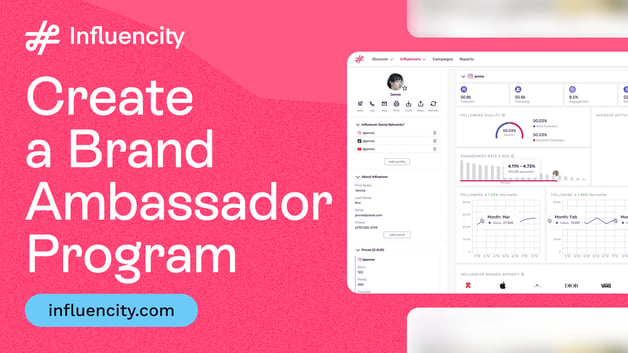Optimizing Influencer Marketing ROI: Effective Measurement Strategies
Influencer marketing is growing at a rapid pace. Not only that, but it’s evolving to get smarter and more measurable. And this makes it easier to track your influencer marketing ROI so that you can rest assured that you are getting a high return on your marketing investment.
Despite this fact, according to statistics, only 67% of brands measure the return on investment (ROI) from their influencer campaigns, either because they claim to not have time, or more often than not, because they don’t know how to.
Do you know how to track the ROI of your influencer marketing efforts? Are you aware of all the marketing KPIs you should be monitoring to find out if your campaigns are as successful as you’d like them to be?
If not, then read on to find out everything you need to know to get started.

What is influencer marketing ROI?
Influencer marketing ROI is an all-encompassing metric used to calculate the return on your investment when you launch an influencer marketing campaign. The metric looks at the money you spend on your campaign and compares it to the money you make in return.
Essentially, influencer marketing ROI is a measuring tool that helps you figure out whether your influencer partnerships are successful and profitable and if your investment is worth it. This information helps you plan and improve your marketing strategies and make smarter decisions in the future, like choosing the right influencers and deciding where to invest your resources. In other words, the changes you can make to ensure that your influencer collaboration boosts your brand and brings in more cash for your business.
The Importance of ROI in Influencer Marketing
Measuring influencer marketing ROI is essential for several reasons. Firstly, it helps brands allocate their marketing budgets more effectively. By understanding which influencers and social media platforms generate the most ROI, businesses can make informed decisions about where to invest their resources.
Secondly, influencer marketing ROI analysis can identify areas for improvement in your influencer marketing strategies. By tracking metrics such as sales, website traffic, and overall reach, brands can identify which campaigns are performing well and which ones need to be optimized.
Thirdly, influencer marketing ROI demonstrates the value of this marketing investment to stakeholders. Brands can showcase the financial impact of their influencer campaigns to investors, partners, and executives, justifying their investment in influencer marketing and its contribution to overall business growth.
Ultimately, influencer marketing ROI is a critical metric for evaluating the effectiveness of your influencer marketing campaigns and ensuring that you are investing your resources in strategies that deliver measurable results. By understanding and tracking this information, you can maximize the return on your influencer marketing efforts and drive sustainable growth.
Types of ROI in Influencer Marketing
Influencer marketing ROI can be categorized into two main types: direct ROI and indirect ROI.
By measuring both direct and indirect ROI, brands can gain a comprehensive understanding of the overall impact of their influencer marketing campaigns. This information can be used to refine strategies, optimize influencer partnerships, and make data-driven decisions that maximize the return on investment in influencer marketing.
Direct Sales ROI
Direct sales ROI is the most tangible measure of influencer marketing success, as it directly links the campaign to financial gains. However, it often represents a small portion of the overall impact of influencer marketing.
Specifically, direct ROI measures the immediate financial impact of influencer marketing campaigns.
This includes metrics such as:
- Direct sales ROI: Tracking the number of sales or leads generated directly from influencer-promoted content. Using influencer discount codes or custom links can help you identify which sales come directly from influencer content vs. paid ads. Direct sales ROI = (Total sales generated from direct marketing - Total direct marketing costs) / Total direct marketing costs x 100.
- Return on ad spend ROI: Measuring the amount of revenue generated for every dollar spent on advertising. ROAS = (Revenue generated from advertising / Advertising costs) x 100.
- Cost Per Acquisition (CPA) ROI: Evaluating the average cost of acquiring a new customer or lead through influencer marketing. CPA ROI = (Total revenue generated from acquired customers / Total cost of acquiring customers) x 100.
Indirect Sales ROI
Indirect ROI measures the longer-term and more intangible benefits of influencer marketing.
This includes metrics such as:
-
Brand awareness ROI: Tracking the increase in brand awareness and positive sentiment generated by influencer campaigns. The best way to measure brand awareness is to use traditional metrics such as brand recall and brand recognition. For example, brands can conduct pre and post-campaign surveys to measure changes in brand recall and recognition scores among target audiences.
-
Customer engagement ROI: Measuring the level of engagement with influencer-generated content, such as likes, shares, and comments. A common approach to measuring customer engagement involves tracking traditional metrics such as website traffic and social media engagement.
-
Customer loyalty: Analyzing the impact of influencer marketing on customer retention, repeat purchases, and positive word-of-mouth.
Indirect ROI may not be directly measurable in terms of financial gains, but it contributes to the long-term growth and sustainability of the brand. It helps to build brand reputation, foster customer loyalty, and create a positive brand image, which can lead to increased sales and revenue over time.
6 Steps to Calculate Influencer Marketing ROI
There are a number of steps you have to follow in order to determine your influencer marketing ROI:
- Goals: Firstly, you need to set your influencer marketing goals. Do you want your campaign to raise brand awareness? Increase followers? Drive more traffic to your website? Increase sales? It’s important to know what your main objective is so that you know in which direction you should be headed. This makes it much easier to quantify your performance and determine whether or not your campaign is a success.
- Influencer tracking: Secondly, once you’ve established your campaign objectives, you need to determine which influencer marketing KPIs are most relevant to your goal. Then make sure you have the right tools in place to accurately measure your KPIs.
- Strategy and platform: The next step is deciding which marketing strategy and platform will help you meet your goals.
- Evaluate your expenses: You also need to calculate how much you are investing in your campaign. Make sure you include any influencer or agency fees, production costs, or fees for analytics software.
- Determine your campaign revenue: This will depend on the goals of your campaign. For example, if your objective is to achieve increased sales, you might get your influencer to share a discount coupon during their campaign. That way you can calculate which sales have occurred as a direct result of their campaign.
Calculate your influencer marketing ROI: Finally, you need to use all the information collected to calculate your ROI. The formula is simple:
(Revenue/Cost) x 100
For instance, let’s imagine your goal was to increase sales. You invested $50 in a campaign and received $1000 profit from direct sales. Your ROI would therefore be 1000/50 x 100 = ROI 2,000%. Voila!
What Influencer Marketing KPIs You Should Track?
There are several influencer marketing KPIs that you need to track in order to calculate your influencer marketing ROI. The specific metrics you use will, of course, depend on the goals of your campaign. However, generally speaking, you should aim to track the following:
- Revenue and conversions
- Page views and impressions
- Engagement
- Earned media value (EMV)
- Number of followers
We touched on the difference between direct and indirect ROI and the influencer marketing metrics you can use to calculate these two types of ROI, but let’s look into the above IM ROI metrics in a bit more detail now to help you understand why they are so important.
Revenue and Conversions
Revenue and conversions are two of the most important KPIs (key performance indicators) in influencer marketing because they measure the financial impact of influencer campaigns.
Revenue is the total amount of money that a brand generates from sales of its products or services as a result of an influencer campaign. Conversions is the number of people who take a desired action, such as making a purchase, signing up for a newsletter, or downloading a whitepaper, as a result of an influencer campaign.
Tracking revenue and conversions allows brands to:
- Measure the effectiveness of their influencer marketing campaigns.
- Identify the best influencers to partner with.
- Improve the ROI of their influencer marketing campaigns.
Here are some specific examples of how brands can track revenue and conversions from their influencer marketing campaigns:
- Use unique URLs or promo codes to track sales directly to influencer campaigns.
- Track website traffic and form submissions from influencer posts.
- Monitor customer reviews and social media mentions to track brand awareness and sentiment.
Page Views and Impressions
Page views and impressions are two important metrics used to measure the reach and engagement of influencer marketing campaigns.
The page views metric is the number of times that a specific page on a website has been loaded. This KPI can be used to track the number of people who have seen an influencer's post, and it can also be used to measure the effectiveness of a landing page that is being promoted by an influencer.
The impressions metric is the number of times that an ad or piece of content has been displayed on a screen. This metric can be used to track the overall reach of an influencer's campaign, and it can also be used to measure the frequency with which an influencer's audience is exposed to their content.
Page views and impressions are important influencer marketing ROI metrics because they can help brands track the overall success of their campaigns. By understanding how many people are seeing their content, brands can make adjustments to their campaigns to improve their reach and engagement.
Engagement
Engagement is a key indicator that measures how effectively an influencer marketing campaign is connecting with the target audience. It involves measuring the level of interaction that occurs between the influencer, the brand, and the audience, such as:
- Likes, shares, and comments on social media posts.
- Click-through rates on links and calls-to-action.
- Downloads of landing pages or other materials.
- Increased website traffic.
- Rise in brand awareness and sentiment.
Engagement is essential for calculating influencer marketing ROI because it demonstrates that the campaign is generating interest and excitement among the target audience. A high level of engagement indicates that the influencer is successfully connecting with their audience and that the brand's message is resonating. This information can then be used to optimize your influencer marketing campaigns and improve the overall return on your investment (ROI).
Earned Media Value (EMV)
Earned media value (EMV) is a crucial metric used to assess the overall value of your influencer marketing campaigns. It measures the monetary equivalent of the publicity or media coverage generated from influencer-sponsored content, including social media posts, blog reviews, and media mentions.
EMV is an important influencer marketing KPI because it:
- Provides a holistic view of the campaign's impact.
- Goes beyond direct sales or conversions, measuring the indirect value of brand awareness and reputation.
- Helps brands compare the value of different influencer partnerships.
- Guides future influencer marketing strategies and budget allocation.
EMV is calculated by evaluating the following factors:
- Media impressions: The total number of times an influencer's content is viewed or shared across various platforms.
- Social media engagement: The level of interaction with the content, such as likes, comments, and shares, indicating the level of interest generated.
- Media mentions: The volume and reach of media articles, blog posts, or reviews that reference or feature the brand or product promoted by the influencer.
- Brand sentiment: The overall tone and attitude of online discussions related to the influencer's content, indicating the positive or negative perception of the brand.
Number of Followers
Finally, this influencer marketing ROI metric is used to measure the reach and potential impact of an influencer. This information is useful at the initial research stage as it helps you evaluate an influencer's potential impact. A higher number of followers suggests a larger audience base that the influencer can potentially reach with their content. However, while the number of followers can be a starting point for evaluating an influencer, it's crucial to consider other relevant KPIs to gain a more holistic understanding of their impact. By evaluating engagement rate, audience demographics, niche fit, and brand sentiment, brands can make informed decisions about selecting the right influencers for their marketing campaigns, maximizing their return on investment and achieving their overall marketing goals.
What Is a Good Influencer Marketing ROI?
Ultimately, there is no universal standard for measuring influencer marketing ROI. A successful campaign for one brand might be deemed less successful by another. It all depends on the ultimate goals of your campaign and how much you have invested.
However, to give you an idea in general terms, studies have found that on average, businesses earn $5.20 for every dollar spent on influencer marketing. This figure reflects the overall value that influencer marketing can generate for brands when executed effectively.
How to Measure ROI Easily with Influencer Marketing Software
Influencer marketing platforms help you centralize each stage of the influencer process. Using a centralized platform like Influencity will not only save you valuable time, but you will also get access to the right influencer tools to track your influencer marketing ROI.
With Influencity, you get a full spectrum of influencer marketing tools and features that help you find the right influencers and track the performance of your influencer analytics so that you can be sure your campaign is a success, and you get the biggest return on your investment.
For example, you get:
- An influencer search tool with advanced filters that allow you to filter accordiong to audience demographics, follower quality, interests, hashtags used, and more. Once you’ve found what you’re looking for, you can view details about the influencer on their profile page to make sure they’re a good fit for your brand.
- An influencer relationship management tool where you can save interesting influencer profiles and keep track of their contact details, pricing, and emails exchanged. Not only does this tool let you keep all relevant information in one place, it also offers a host of useful metrics such as follower quality, follower age distribution, and brand affinity. This puts all the important insights at your fingertips to help you make the right choice for your campaign.
- Tracking tools to monitor your defined KPIs and identify how well an influencer is performing. In other words, whether or not they are effectively promoting your brand.

Tags:




















%20and%20How%20Can%20They%20Benefit%20Your%20Brand%20article.jpg?length=628&name=What%20Are%20Key%20Opinion%20Leaders%20(KOL)%20and%20How%20Can%20They%20Benefit%20Your%20Brand%20article.jpg)








